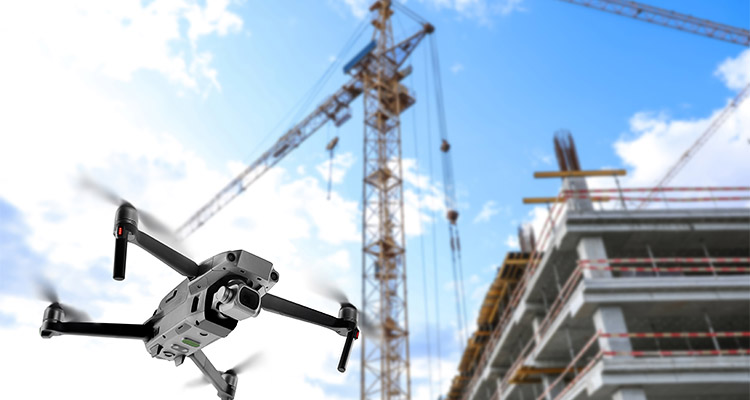Robert Garbett, Founder and Chief Executive Officer of Drone Major, shares how drones will undoubtedly revolutionise the construction sector, bringing new, safer and lower cost capabilities
You’ve been a prominent advocate for the drone industry for years. What first drew you to the world of unmanned aerial systems, and how did that lead to the founding of Drone Major?
An inspirational young lady called Tina Brevitt approached me in 2013, seeking assistance with an organisation that she had created to support UK air drone operators called the Society for Unmanned Air Systems (SUAS). Tina had found me on Linkedin and, due to my military background in the development of policies and standards for military drones as well as my CAA Airworthiness certification, she asked for my help to develop the network. I agreed and we set about developing an online software network solution, and a marketing campaign which evolved the network from 124 members to over 40,000.
Along this journey, Tina asked me to attend a meeting with the British Standards Institution (BSI) at which I was asked to represent the UK at a new committee at

the International Organization for Standardization (ISO). I led on the development of the international safety and quality standard for Uncrewed Air Systems (UAS) Operations (ISO21384-3) until 2024 when I retired to focus on our Digital Tethering™ concept. The network was later renamed Surface Underwater, Air & Space Global (SUAS Global) and, in 2016, I bought the company and transitioned the business elements of the network into Drone Major which was launched in 2017 at the House of Lords.
Drone Major has just received CAA Operational Authority for BVLOS flights over critical national infrastructure – a UK first. Can you walk us through the journey to achieving this milestone, and what it means for the future of UK drone operations?
The concept of Digital Tethering™ was born during the first Covid lockdown as I found that I had time to consider what was stopping the UK air drone industry from fully commercialising. My conclusion was that the use of GPS as a core navigation solution and the lack of sufficient flight assurance were the two key issues so I set about devising a solution to overcome this and Digital Tethering™, which has a stack of navigational solutions, both GPS and non-GPS together with a certifiable (to DO178) software based Safety Assurance System (SAS), was born. I did enter this idea into the first Future Flight challenge, but the idea was rejected so I pursued other avenues and eventually presented the concept to Network Rail in 2022. The idea was well received, and we were contracted to run a proof-of-concept trial in July 2023.
From there, the hard work of turning a concept into reality and the struggle to get the Civil Aviation Authority (CAA) to understand and accept the concept began. The CAA liked the idea and was supportive and professional, but this was a first of a kind, so a great deal of caution was exercised in assessing the operational Safety Case (OSC). In May 2024, we were awarded a limited Operational Authority (OA) to fly two kilometres Beyond Visual Line of Sight (mitigated) BVLOS(M) from Wolverhampton station, which meant that we had to have observers every 500 metres on every flight and finally, following what seemed like an age, the CAA accepted our safety arguments and a full BVLOS OA was issued in May 2025. This represents a monumental move to the commercialisation of the UK drone industry for UAS operations in highly complex urban areas, in close proximity to Critical National Infrastructure (CNI) and uninvolved members of the public.
How do you see this approval transforming the way drones are used in construction and civil engineering, particularly on large-scale infrastructure projects like highways, rail, or energy networks?
 The Digital Tethering™ concept has the potential to provide a much needed ‘Business as Usual’ solution to a number of challenges facing Network Rail and other CNI organisations, such as trespass management and security, and inspections and asset management. We are looking forward to the next phase of work with Network Rail during which we will demonstrate and challenge the system to see what the possible applications are while we evolve the technology. Beyond that, we hope that Network Rail will work with us to scale the system to relevant areas of the network.
The Digital Tethering™ concept has the potential to provide a much needed ‘Business as Usual’ solution to a number of challenges facing Network Rail and other CNI organisations, such as trespass management and security, and inspections and asset management. We are looking forward to the next phase of work with Network Rail during which we will demonstrate and challenge the system to see what the possible applications are while we evolve the technology. Beyond that, we hope that Network Rail will work with us to scale the system to relevant areas of the network.
Alongside this, we are now working with several CNI organisations here in the UK and in Europe to trial new applications in atypical and low level non-segregated airspace. Our aim has always been to create a solution which can be used on any reasonably sized UAS by any company (under licence) and we are already working with a number of UAS manufacturers to make this a reality. Digital Tethering™ has been on an amazing journey from an idea in lockdown to reality five years later and I am excited to see where we can take it to push the commercialisation of the drone industry in the UK and beyond.
The approval involves flying in non-segregated airspace over complex and built-up areas. How is Drone Major addressing safety, regulatory compliance, and public confidence in this new operational paradigm?
We have an amazing team of specialists who have been working closely with Network Rail and the CAA to ensure that every aspect of air and ground risk has been extremely carefully considered and mitigated. This has enabled us to fly BVLOS over live road networks (another UK first) and very close to populated areas which is testament to the professionalism of the Drone Major team and the diligence of the CAA who, quite rightly, really took us to task.
I can’t discuss the details of how we achieved this as it is commercially sensitive, but I can say that we are launching a training course to assist other operating companies to achieve an Operational Authority through the new Specific Operational Risk Assessment (SORA) system launched earlier this year. We want other companies to use the Digital Tethering™ concept to achieve what we have so that we can accelerate the commercialisation of an industry which had, until now, been falling behind other countries.
What kind of technologies, in terms of sensors, software, or AI, underpin the BVLOS systems approved by the CAA, and how do they assure safe and predictable flight behaviour?
Obviously, the details of our solution are commercially sensitive, but I can say that the Digital Tethering™, the Patent for which was registered in the UK and internationally, has a stack of navigational solutions both GPS and non-GPS together with a certifiable (to DO178) software-based Safety Assurance System (SAS). The navigation stack can be adjusted to suit the application and environment and the SAS can be quickly adapted to ensure that the UAS only does what it is supposed to do and does not do anything that it is not supposed to do without executing immediate action such as slowing, stopping and landing either immediately or at the closest designated safe landing zone. The system is certifiable to manned aviation standards so it is as close to fool proof as we can get. In the case of the rail network application, it keeps the aircraft in a tight air corridor, the deviation from which will result in immediate safety mitigation action being taken.
From your perspective, what are the most promising use cases for BVLOS drone technology in construction, for example, in monitoring progress, surveying hazardous zones, or enhancing project management?
The BVLOS applications in construction are extensive but the main, low hanging fruit, would be safety and security monitoring, trespass management and asset management. The construction industry has been using drones for a long time in Visual Line of Sight (VLOS), but the Digital Tethering™ concept opens a huge potential for wider use, especially on larger sites and, due to the non-GPS capability of the system, even underground!
Drone Major is known for working with a wide network of partners. How important is collaboration, with government, technology providers, and industry bodies, in advancing drone capabilities across sectors like civil engineering?
Collaboration is at the heart of what we do, and we have created a massive global network of over 7000 companies in the Robotics and Autonomous System (RAS) space, which we leverage to deliver projects, primed by Drone Major, to our clients. Drone Major has always been heavily involved in the role as advisor to both government and non-governmental agencies, either through direct engagement on key issues, the development of standards essential for the development of the industry or through the delivery of white papers through organisations set up by Drone Major such as the Drone Delivery Group (www.dronedeliverygroup.org). Of course, there are a huge number of industry bodies available which we collaborate with as appropriate such as the National Physics Laboratory (NPL), however, we have not engaged very much with R&D organisations as we do not feel that these offer the support needed by the industry.
As drone operations become more integrated with national infrastructure projects, what skills do you think the construction and civil engineering workforce will need to develop to fully leverage drone technologies?
I have long held the belief that organisations looking to utilise RAS technologies should do so through a specialised organisation as the skills needed to develop, integrate and operate such systems safely would detract from the skills needed to manage and implement a successful construction project. The drone industry is set up to deliver such support and services to sectors such as construction, so it makes commercial sense to outsource these capabilities.
Beyond rail networks, where do you see the greatest opportunities for BVLOS drones in UK infrastructure?
The Digital Tethering™ solution can now be transposed across two key types of CNI: firstly, linear transport CNI infrastructures such as rail, and road and energy infrastructure such as pipelines and powerlines. Beyond this, the planar solution is well suited to operations over defence infrastructure and energy installations such as power stations and wind/solar farms.
This CAA approval sets a precedent, but what changes or developments would you like to see from UK regulators or policymakers to further unlock drone innovation in the built environment?
The UK CAA has made significant steps towards simplifying and speeding up the process to obtain an OA by implementing the SORA system but the models /frameworks behind this system to enable SAIL3 and above application in the specific category do not yet exist. As Drone Major evolves the applications for Digital Tethering™, these models/frameworks will be essential so we continue to work with and support the CAA by providing SORA models for our operations which could be used as future SORA frameworks.
